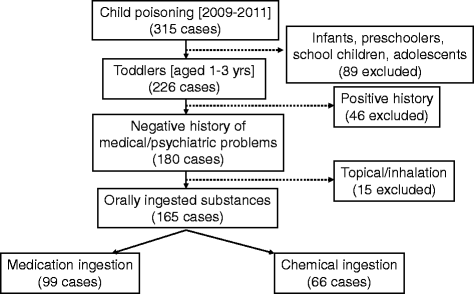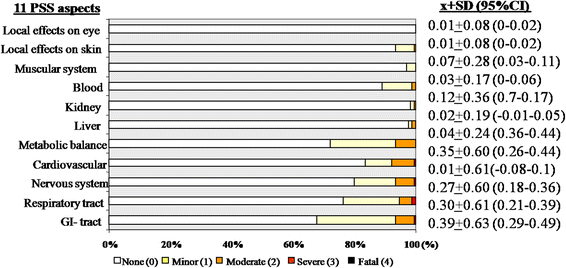Severity scores and their associated factors among orally poisoned toddlers: a cross sectional single poison center study
- PMID: 26729401
- PMCID: PMC4700756
- DOI: 10.1186/s40360-015-0044-7
Severity scores and their associated factors among orally poisoned toddlers: a cross sectional single poison center study
Abstract
Background: One of the most unfortunate events toddlers may encounter during their early years of curiosity and experimentation is substance poisoning. The aim of the study was to evaluate the poison severity score and its associated factors among toddlers with orally ingested substances at a pediatrics emergency department (ED), central Saudi Arabia.
Methods: A cross-sectional, poisoning report review between 2009&2011 was conducted. Exposures were patient characteristics (sex, age, body mass index, medical history) and incident characteristics (substance type, amount, form, witnessed or not, home remedy, arrival time to ED). Outcome was Poison Severity Score (PSS) that rates signs/symptoms of 11 body aspects on scale 0-4 (none, minor, moderate, severe, fatal).
Inclusion criteria: age (1-3 years), previously healthy and oral exposure route. Bivariate analysis and multi-linear regression were conducted. Significance at p < 0.05.
Results: Eligible cases were 165/315(52 %). Males (58 %) and females (42 %) had normal BMI (70 %). Substances ingested were medications (60 %) and chemicals (40 %). Almost 85 % were witnessed incidents and 27 % received a home remedy (water, juices, dairy products, salt/sugar solutes, and/or manually induced vomiting). Delayed arrival (≥1 hour) was observed in 57 %. Composite mean PSS of total was (0.16 ± 0.21), and was highest at the gastrointestinal (GI) aspect (0.39 ± 0.63), metabolic balance (0.35 ± 0.60), and respiratory aspect (0.30 ± 0.61). Significantly associated factors with higher severity scores were: home remedies at the composite mean PSS (adj.p = 0.048), chemical poisoning at two aspects respiratory (adj.p = 0.047) and muscular (adj.p = 0.009) compared to medication poisoning. Unwitnessed incidents at the muscular aspect (adj.p = 0.026) compared to witnessed incidents; delayed arrival time to ED at three aspects GI (adj.p = 0.001), nervous system (adj.p = 0.014) and kidney (adj.p < 0.001).
Conclusions: Parents are not recommended to provide any home remedy to their orally poisoned toddlers, but rather directly visit the ED. Physicians are expected to observe more severe clinical outcomes among toddlers with chemical poisoning, unwitnessed incidents, and delayed arrival times especially at the respiratory, GI, muscular, nervous and kidney aspects.
Figures
Similar articles
-
Comparative outcome analysis of home-initiated non-medical interventions among toddlers with orally ingested substances.Ital J Pediatr. 2015 Sep 15;41:63. doi: 10.1186/s13052-015-0170-2. Ital J Pediatr. 2015. PMID: 26373531 Free PMC article.
-
Hospital Performance Indicators and Their Associated Factors in Acute Child Poisoning at a Single Poison Center, Central Saudi Arabia.Medicine (Baltimore). 2015 Dec;94(52):e2339. doi: 10.1097/MD.0000000000002339. Medicine (Baltimore). 2015. PMID: 26717371 Free PMC article.
-
Methylphenidate poisoning: an evidence-based consensus guideline for out-of-hospital management.Clin Toxicol (Phila). 2007 Oct-Nov;45(7):737-52. doi: 10.1080/15563650701665175. Clin Toxicol (Phila). 2007. PMID: 18058301
-
Atypical antipsychotic medication poisoning: an evidence-based consensus guideline for out-of-hospital management.Clin Toxicol (Phila). 2007 Dec;45(8):918-42. doi: 10.1080/15563650701665142. Clin Toxicol (Phila). 2007. PMID: 18163235
-
[Acute intoxication in adults - what you should know].Dtsch Med Wochenschr. 2014 Jan;139(1-2):31-46; quiz 43-6. doi: 10.1055/s-0033-1359902. Epub 2014 Jan 3. Dtsch Med Wochenschr. 2014. PMID: 24390849 Review. German.
Cited by
-
A Methodological Review of Drug-Related Toxicological Studies in Saudi Arabia.Cureus. 2023 Mar 19;15(3):e36369. doi: 10.7759/cureus.36369. eCollection 2023 Mar. Cureus. 2023. PMID: 37082486 Free PMC article. Review.
-
Pharmacological Features and Therapeutic Implications of Plumbagin in Cancer and Metabolic Disorders: A Narrative Review.Nutrients. 2024 Sep 8;16(17):3033. doi: 10.3390/nu16173033. Nutrients. 2024. PMID: 39275349 Free PMC article. Review.
-
The Relative Risk of Toxico-Clinical Parameters with respect to Poisoning Severity and Outcomes in Patients with Acute Poisoning.Adv Biomed Res. 2022 Nov 28;11:107. doi: 10.4103/abr.abr_290_21. eCollection 2022. Adv Biomed Res. 2022. PMID: 36660757 Free PMC article.
-
Development and Validation of Indicators for Population Injury Surveillance in Hong Kong: Development and Usability Study.JMIR Public Health Surveill. 2022 Aug 18;8(8):e36861. doi: 10.2196/36861. JMIR Public Health Surveill. 2022. PMID: 35980728 Free PMC article. Review.
References
-
- Litovitz T, White NC, Watson WA. Epidemiology of pediatric poison exposures: an analysis of 2003 poison control center data. Clin Pedia Emer Med. 2005;6(2):68–75. doi: 10.1016/j.cpem.2005.04.001. - DOI
Publication types
MeSH terms
LinkOut - more resources
Full Text Sources
Other Literature Sources
Medical



